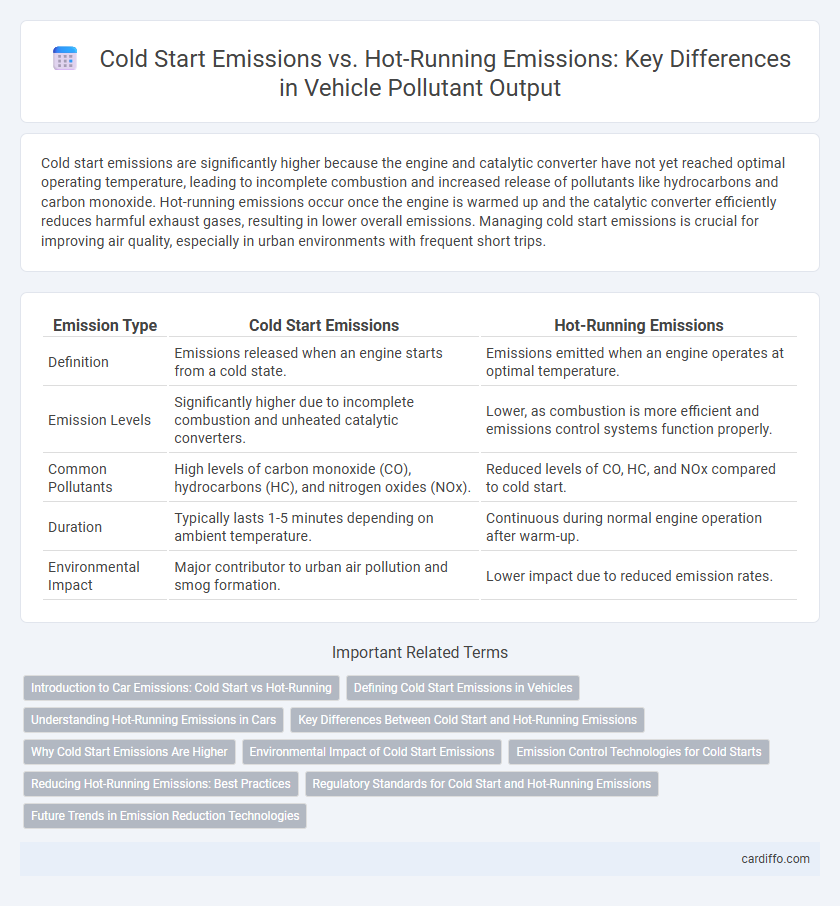Cold start emissions are significantly higher because the engine and catalytic converter have not yet reached optimal operating temperature, leading to incomplete combustion and increased release of pollutants like hydrocarbons and carbon monoxide. Hot-running emissions occur once the engine is warmed up and the catalytic converter efficiently reduces harmful exhaust gases, resulting in lower overall emissions. Managing cold start emissions is crucial for improving air quality, especially in urban environments with frequent short trips.
Table of Comparison
| Emission Type | Cold Start Emissions | Hot-Running Emissions |
|---|---|---|
| Definition | Emissions released when an engine starts from a cold state. | Emissions emitted when an engine operates at optimal temperature. |
| Emission Levels | Significantly higher due to incomplete combustion and unheated catalytic converters. | Lower, as combustion is more efficient and emissions control systems function properly. |
| Common Pollutants | High levels of carbon monoxide (CO), hydrocarbons (HC), and nitrogen oxides (NOx). | Reduced levels of CO, HC, and NOx compared to cold start. |
| Duration | Typically lasts 1-5 minutes depending on ambient temperature. | Continuous during normal engine operation after warm-up. |
| Environmental Impact | Major contributor to urban air pollution and smog formation. | Lower impact due to reduced emission rates. |
Introduction to Car Emissions: Cold Start vs Hot-Running
Cold start emissions occur when a vehicle's engine is started from a cold state, causing incomplete combustion and higher release of pollutants like carbon monoxide, hydrocarbons, and nitrogen oxides. Hot-running emissions refer to pollutants emitted after the engine has reached its optimal operating temperature, resulting in more efficient fuel combustion and generally lower emission levels. Understanding the difference between cold start and hot-running emissions is crucial for developing strategies to reduce overall automotive pollution and meet regulatory standards.
Defining Cold Start Emissions in Vehicles
Cold start emissions in vehicles refer to the pollutants released during the initial phase of engine operation before it reaches optimal operating temperature. This period results in higher emissions of unburned hydrocarbons, carbon monoxide, and nitrogen oxides due to incomplete fuel combustion and inefficient catalytic converter performance. Measuring and controlling cold start emissions is critical for meeting stringent environmental regulations and reducing urban air pollution.
Understanding Hot-Running Emissions in Cars
Hot-running emissions occur when a car's engine reaches its optimal operating temperature, resulting in the combustion system performing efficiently but still producing pollutants such as nitrogen oxides (NOx) and carbon monoxide (CO). These emissions are influenced by factors including fuel composition, engine design, and exhaust after-treatment systems like catalytic converters. Understanding hot-running emissions is critical for developing advanced emission control technologies and meeting stringent environmental regulations aimed at reducing air pollution from vehicles.
Key Differences Between Cold Start and Hot-Running Emissions
Cold start emissions occur when an engine is started from a cold state, resulting in incomplete combustion and higher levels of hydrocarbons, carbon monoxide, and nitrogen oxides due to insufficient catalyst temperature. Hot-running emissions happen after the engine reaches optimal operating temperature, leading to more efficient combustion and significantly lower pollutant outputs. The key differences lie in emission volume, with cold starts producing peak pollutant levels, while hot-running emissions maintain relatively stable and reduced concentrations over time.
Why Cold Start Emissions Are Higher
Cold start emissions are higher because the engine operates at lower temperatures, causing incomplete combustion and increased release of hydrocarbons and carbon monoxide. During cold starts, the catalytic converter has not reached optimal operating temperature, reducing its efficiency in converting harmful pollutants. This results in significantly higher emissions compared to hot-running conditions when the engine and emission control systems function at peak performance.
Environmental Impact of Cold Start Emissions
Cold start emissions release higher concentrations of carbon monoxide, hydrocarbons, and nitrogen oxides compared to hot-running emissions, significantly contributing to urban air pollution and smog formation. These pollutants arise because the catalytic converter operates inefficiently until the engine reaches optimal temperature, exacerbating ground-level ozone and respiratory health problems. Mitigating cold start emissions through improved engine technology and fuel formulations is critical for reducing the environmental impact of vehicle exhaust in metropolitan areas.
Emission Control Technologies for Cold Starts
Cold start emissions are significantly higher than hot-running emissions due to incomplete fuel combustion and lower catalytic converter efficiency at low temperatures. Emission control technologies for cold starts include advanced fuel injection systems, fast-heating catalytic converters, and secondary air injection to quickly elevate exhaust temperature and reduce hydrocarbons and carbon monoxide. These systems optimize fuel-air mixture atomization and accelerate catalyst light-off, effectively minimizing pollutant output during engine warm-up phases.
Reducing Hot-Running Emissions: Best Practices
Reducing hot-running emissions involves optimizing engine calibration and implementing advanced exhaust after-treatment systems such as selective catalytic reduction (SCR) and diesel particulate filters (DPF). Regular maintenance of fuel injectors and air intake systems ensures efficient combustion, minimizing NOx and particulate matter output during prolonged operation. Utilizing low-sulfur fuels and improving thermal management techniques also contribute significantly to lowering hot-running emission levels in modern internal combustion engines.
Regulatory Standards for Cold Start and Hot-Running Emissions
Regulatory standards for cold start emissions typically impose stricter limits due to the increased pollutant output during engine warm-up, especially for hydrocarbons (HC) and carbon monoxide (CO). Hot-running emissions standards focus on controlling nitrogen oxides (NOx), particulate matter (PM), and carbon dioxide (CO2) during stable engine operation, with regulations such as Euro 6 and EPA Tier 3 specifying maximum allowable values. Compliance with these standards requires advanced emission control technologies like catalytic converters and particulate filters calibrated for both cold start and hot-running conditions.
Future Trends in Emission Reduction Technologies
Advancements in emission reduction technologies target both cold start emissions, which spike due to inefficient combustion during engine warm-up, and hot-running emissions produced under stable operating conditions. Future trends emphasize catalytic converters with improved light-off performance and advanced thermal management systems to minimize cold start emissions. Integration of electrification and AI-driven engine control optimizes combustion efficiency, reducing hot-running emissions while meeting stringent regulatory standards.
Cold start emissions vs Hot-running emissions Infographic

 cardiffo.com
cardiffo.com